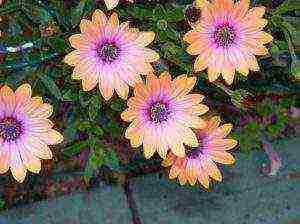Content
In order for your flower garden to be decorated with magnificent dahlias, planting and growing must go through all the rules. Lush bushes are suitable for the center of a flower bed composition or as a decorative screen between the zones of a summer cottage. Dwarf varieties can be used for curbs, and they are grown in pots to decorate interiors. Breeders have bred varieties with all kinds of petal shapes and flower structures, it is difficult to list all the shades of dahlias: from snow-white to almost black.
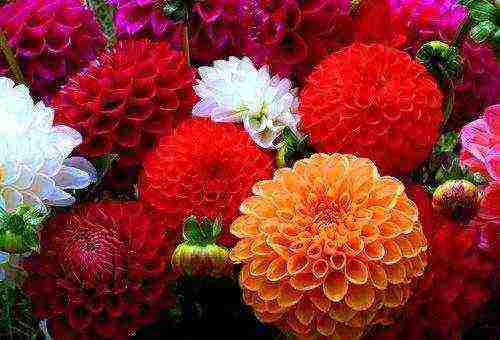
There is one point in which the plant shows character: its inflorescences do not want to take on a blue color. Both experienced breeders and amateur flower growers are fighting over this problem, but there is no solution yet. Try experimenting: pollinating, grafting, using different varieties of seeds, you may be able to create an unprecedented color.
Receiving seed
How to choose the right course in the sea of sizes, shapes and colors of dahlias? First of all, think: do you want to dig up tubers every fall, store them in the right conditions, and plant them in the spring? Please note that the main work will have to be done at the most difficult time: it is time to harvest potatoes, cabbage, beets, prepare the beds for the new season - and flower tubers also cannot stay in the ground, the first frosts can destroy them. The warm time has come, when, according to the proverb, one day will feed the whole year - and the roots are already asking for the ground. Do not be afraid of difficulties - a perennial variety at your service. If additional concerns are not to your liking, annuals from seeds will help out.
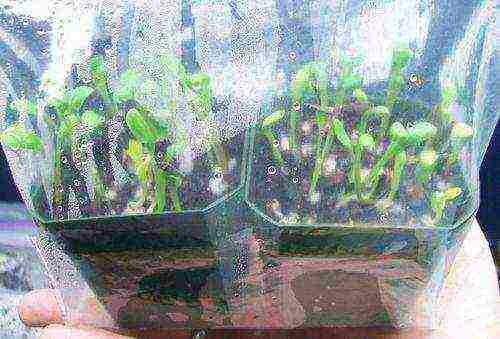
If you want the site to be decorated with annuals - grow flowers from seeds. You can sow grains in the spring directly into the ground, but then the flowerbed will be colored with a flowering carpet by the end of summer, and in Siberia and the northern regions, the plants may not have time to bloom. This method is suitable if plants are planted on the lawn that bloom from May to July. How to plant dahlias so that a colorful composition will delight the eye all summer? Grow flowers through seedlings.

In April, take containers of disinfected sand, pour a bag of seeds onto the surface and cover with a sand layer. Pour well, cover with plastic wrap or a lid, and place in a warm place with a temperature of 25⁰ to 27⁰. Seedlings will appear in about 2 weeks. When the third true leaf comes out, cut the seedlings into separate cups and grow until planting in the flower bed.
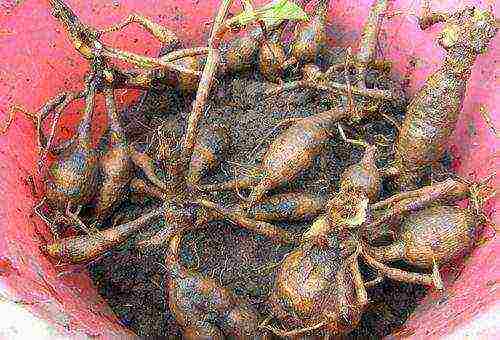
Tubers of perennial species must be divided into parts every spring. Rhizomes grow strongly during the season, and many roots can be separated from one bush for planting. When tubers germinate, many lateral shoots appear, which growers cut off. They can be rooted and planted in open ground. Therefore, the reproduction of perennial dahlias can be carried out in three ways:
- From seeds the same as annuals.
- By dividing the rhizome.
- Cuttings.
Planting dahlias in open ground
Before looking for an answer to the question of how to plant dahlias, choose the right place for planting. These flowers do not tolerate stagnant damp air; they must be planted in a ventilated area.Just do not arrange a flower bed in a narrow gap between buildings: these flowers will not grow in a draft or in places where the sun rarely gets. Excellent conditions for them will be on an open light lawn or on the south side of the house, where dense bushes hold back strong gusts of wind. It is advisable to change the landing site every season, and only after 3 years it will be possible to return to the previous site.

The soil should be with a neutral reaction, a slight deviation towards the acidic side is allowed. Check the pH, if the value is below 5, add lime to the soil, if more than 7, add peat. When digging in the fall, put half a bucket of compost or humus per square meter. In the spring, you can also add compost and some ash. Do not overdo it with alkaline dressings, they can be poured safely only on very acidic soils.
Tubers for planting should be started in early spring, in April. Inspect the rhizomes, separate diseased, dry and damaged parts, and treat with a disinfectant. Fill the containers with nutritious soil, plant the tubers so that the tops rise slightly above the ground. Place the boxes in a bright, warm place, moisten the soil and watch for the plants to bud. Then cut the rhizome so that each part has a nascent shoot.
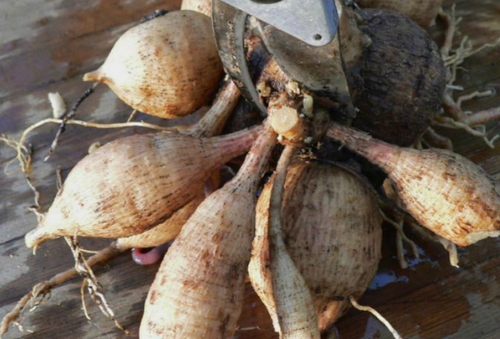
Bury the planting material again in boxes with the ground, and before planting in open ground, leave the central sprouted bud, and cut off all the lateral shoots. If you need a lot of dahlias, stick the cut sprouts in the sand, remove in the dark and keep the soil moist. When the shoots take root, they are planted in a permanent place.
In open ground, tubers and seedlings from seeds in the middle lane are planted in early May. In the Urals, Siberia and the northern regions, you need to be guided by the weather: the soil should warm up well, and the threat of frost should be avoided. Before planting, pits are prepared for planting tubers. They should be 40 cm in diameter and in depth. Cover the bottom with compost or rotted manure, lightly sprinkle with earth on top. Bury the rhizome so that the bottom of the sprouts is buried a few centimeters in the ground. For tall bushes, set up the garter pegs immediately. Water the plantings with cold water and add a layer of mulch of at least 5 cm.
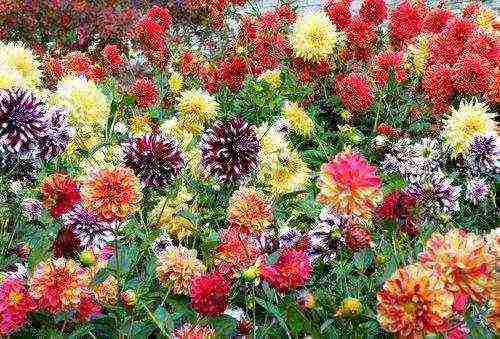
Flower care
In hot, dry weather, dahlias should not be made to suffer from thirst. Watering can be infrequent, enough 2 times a week, but the amount of water should be sufficient to saturate the soil to the planting depth. If the soil is not covered with mulch, hilling can help reduce evaporation. Before watering, rake a mound around the stem, level it with the surface of the soil. Moisten the soil, and then spud the flowers again.
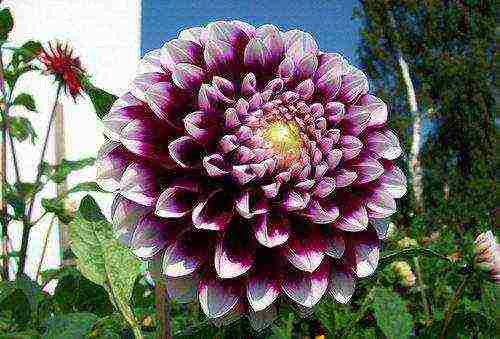
For lush flowering, dahlias need good nutrition, before the buds appear, feed them 2 times a month. First, apply complex fertilizer, after 2 weeks pour with slurry. When flower buds appear, dilute 30 g of phosphorus and potassium fertilizers in a bucket of water and distribute this amount to 8 plants.
If you want to have a bright flowerbed, covered with many inflorescences, dahlias do not need to be pruned. The flowers will be smaller, but no one will notice this defect in the total mass. For bouquets, it is important that each flower is large and even. Select on each shoot no more than 2 of the largest and highest quality buds, remove the rest. Do not let the plants release the lower shoots that take away strength from the main stem, cut off the appearing shoots. Flowers that have begun to wither continue to use nutrients that could be used to form new buds. Notice that the petals begin to dry out - immediately cut off the inflorescence. Annuals from seeds do not need to be cut off.
Problems with growing dahlias
If dahlias are not tied up in time in spring, wind or heavy rain can break fragile stems.Do not rush to throw away the fallen appendage, provide it with the same help as with a bone fracture in animals or humans. Take a sturdy splinter and tie it to the stem so that it is in the correct position. Tie the plant well to a peg so that the damaged shoot does not sway or tilt. With the correct and timely garter, the shoot will recover and soon begin to develop in the same way as intact plants.
The succulent stems and leaves attract many pests. Who can attack flowers?
- slugs,
- earwigs,
- caterpillars,
- thrips,
- ticks,
- aphid.
If you spot parasites, spray the entire flower bed with insecticides.
Advice. If there are not too many pests, try to deal with them without chemicals. In the evening, you can spray the bushes with decoctions of bitter herbs: celandine, wormwood. A solution of laundry soap helps well against aphids.
Wintering tubers
Tubers do not tolerate cold and will die during wintering in open ground. If there is a threat of frost, they need to be dug out of the soil and stored. The first frost is not terrible for rhizomes, but after it usually comes "Indian summer". Plants can mistake temporary warming for the warm season and start sprouting. After that, next year, you can not wait for a full-fledged flowering bush.
Take your time to cut the aboveground part: the cuts are very sensitive, they can rot from dew and rain. Choose a warm, sunny day so the rhizomes can dry out in the fresh air. The succulent stem breaks easily, and if you put the tubers in the shipping bags right away, half of them will be damaged. In the morning, cut off the entire aerial part, leaving a part of the stem no more than 10 cm high.

At a distance of 30 cm from the root collar, use a shovel to cut through the top layer of soil around the plant. Cut through the soil with a full bayonet to cut off long root outgrowths. Gently pick up the tubers with a pitchfork and uproot them. Remove large lumps of earth with your hands, and then rinse the rhizomes with a hose. During the day, the tubers will dry out, become less fragile, and they can be transferred to winter. In the storage, carefully inspect each rhizome, remove diseased, rotten and damaged parts, and treat the cuts and root collar with crushed charcoal.
Tubers winter well in a ventilated place with a temperature of + 5⁰ and a humidity of about 70%. To absorb excess moisture, they can be buried in dry peat or sawdust. Inspect the rhizomes periodically, and if they start to dry, slightly moisten the peat. It is not always possible to find a storage facility with good ventilation, and without ventilation, dahlias will rot. To save the planting material from stagnant humid air, blow a fan for half an hour every other day.
Advice. If there is no suitable storage, dip the rhizomes in molten paraffin and put in a bag, sprinkling with dry sand. The film will not let the tubers dry out or rot. Squeeze or rub the tuber lightly before planting to crack the coating.
Conclusion
In order for your site to be decorated with lush dahlias, cultivation and care must be carried out in accordance with all the rules. Annual species grown from seed require less attention than perennials. They are short, these flowers do not need support. In the fall, you just need to dig up and destroy the faded plants, and plant new seedlings next spring. These types are well suited for framing a flower garden, borders, small flower beds. Your task is to water and feed the plants on time, and a bright carpet will be provided.
Perennial varieties can also be grown from seeds or cuttings, but the simplest flower propagation is rhizome division. Such species are more diverse and beautiful than varieties that grow from seeds one season, but they also require more attention. In winter, it is necessary to ensure proper storage of the tubers, periodically inspect and remove rotten areas.Choose according to your time and possibilities, which varieties you will grow, whether you can provide the necessary care for dahlias. In any case, both dwarf flowering plants and tall bushes will decorate the summer cottage.
Dahlias are a luxurious decoration for any flower bed. Bright, large flowers attract a variety of shapes and colors, while planting and caring for dahlias in the open field is not very difficult.
 Bright and elegant dahlias are a wonderful and demanding decoration of the garden.
Bright and elegant dahlias are a wonderful and demanding decoration of the garden.
When choosing a place where dahlias will settle in the future, you need to take into account the purpose of their cultivation - decorative or reproduction for sale. If the plans include the implementation of dahlia tubers, then the planting scheme will differ from that when growing these flowers to decorate the site.
The recommendations below for planting dahlias and caring for them in the open field are relevant for central Russia and the CIS countries (Primorsky, Altai Territories, the southern part of the Khabarovsk Territory and Western Siberia, the South and Middle Urals, the Baltic States, Belarus, the northwestern part of Ukraine) ... When growing in more southerly regions and countries, you will have to make adjustments for the climate features, shifting the timing of planting and harvesting, as well as changing agricultural technology.
When choosing a place to grow dahlias, you need to take into account their features, including:
- high water demand (the higher the air temperature, the more water is needed);
- short growing season;
- the need for support and a garter due to the fragility of the stems.
It is important to create an optimal microclimate that will allow you to get the maximum decorative effect of dahlias in a relatively short period. The landing site should be protected from cold north, north-east and north-west winds and drafts, warm up well. In combination with a low air temperature (from +1 to -4 degrees), strong winds can cause dahlias to freeze, especially if they were recently planted from greenhouses or greenhouses and did not have time to get the necessary hardening.
In the southern regions, the danger is posed by dry winds - northeastern, eastern and southeastern winds carrying heated dry air. They dry out the soil and the aboveground part of the dahlia, causing the young foliage and plant tops to be burned.
To protect the flower beds with dahlias from the winds, the site is planted with trees, ordinary or fruit, using fences or protective strips. Often the site is given a slope - south or south-east for the middle zone and north or north-west for the southern regions.
Important! Lowlands, hollows, valleys should be avoided, where cold air usually accumulates and late spring frosts often occur.
In the shade of trees or fences, dahlias grow beautifully and retain a high decorative effect if the sun illuminates them for at least half a day. At the same time, planting these flowers in the area of \ u200b \ u200bthe root system of large tall trees should be avoided, since they will not be able to bloom normally and form viable root tubers.
When choosing a site for planting dahlias, great attention should be paid to the issue of the occurrence of groundwater. They should not rise above 60-70 cm from the ground surface. If the water rises higher in the area, a flower bed with dahlias should be artificially raised to protect their root system from decay.
In hot southern regions, on the contrary, they often arrange flower beds with dahlias in a depression surrounded by ramparts of earth. At night, this depression is filled with water to ensure sufficient moisture supply to the roots.
Soil preparation
Dahlias prefer moisture-absorbing, structural soil, which is also highly permeable to water. The wrong choice of soil is very often the cause of the death of dahlias. You can improve the structure of the soil with organic additives:
- humus;
- fresh or rotted manure;
- peat;
- straw cutting;
- compost;
- turf and other materials that are readily degradable in the soil.
In heavy, clayey soils, to improve water permeability, add:
- coarse river sand;
- gravel;
- ash (peat or coal);
- peat;
- coal slag (fine, sieved and washed).
If the site is dominated by sandy soil that does not hold water well and is easily eroded, you can add to it:
- vermiculite or perlite;
- peat;
- clay and other materials to help retain moisture.
Advice: it is not required to clear the soil of gravel or small stones; such additives in any type of soil will not interfere with the normal development of dahlias.
Dahlias are not too demanding on the acidity of the soil and can put up with its excess or lack, but they show the best results on slightly acidic or neutral soils. But strongly alkaline soils inhibit their development and growth. Before planting dahlias, you can analyze the acidity in order to then bring it to the desired indicators:
- at a Ph value of 4-5, slaked lime is introduced into the soil (30-100 kg per 100 square meters);
- at Ph 8 and above, the soil is acidified by introducing peat into it.
The place where dahlias will grow is plowed deeply in the fall - by 30-35 cm. Then, 2-3 weeks before planting the flowers, the soil is dug up or plowed again, paying special attention to harrowing and loosening.
Planting dahlias
Exactly when to plant dahlias outdoors in spring depends primarily on the region. As a rule, in the middle lane this is done after June 1-10, when the last night frosts leave. At this time, already grown tubers are planted. You can plant them earlier - around May 15-20, as soon as the soil warms up enough. Unsprouted tubers are planted, which have pronounced eyes. Shoots appear after 2 weeks. With such a planting, it is necessary to constantly monitor the air temperature and, if there is a threat of frost, cover a flower bed with dahlias.
It is interesting. To obtain even earlier flowering in May, already grown tubers can be planted, but in this case they will need constant shelter from frost and cold air.
Before planting dahlias, you need to prepare seats for them. Next to the stakes driven into the ground, holes are dug in the soil. The distance between plants should be equal to half the height of an adult plant - approximately 60-100 cm, between rows - at least 1 meter.
 It is very important to immediately establish a support for the flower, since if you do this later, there is a very high probability of damage to the root tubers.
It is very important to immediately establish a support for the flower, since if you do this later, there is a very high probability of damage to the root tubers.
Stakes for supporting dahlias must be strong and high - not less than 160-180 cm. It is better to make them from coniferous wood, they will last longer. To increase their service life, they are treated with a 7% solution of ferrous sulfate and painted. Even more durable will be metal stakes - from old pipes or fittings with a diameter of 12-20 mm.
Stakes are driven to a depth of 40 cm, then sprouted tubers are planted in the hole, placing them closer to the support. In this case, the root collar of the tuber should be 4-5 cm below the soil level. If the seedling was obtained from a cuttings or is a hybrid seedling, it is planted deeper, 8-10 cm.
Recommendation: it is better to plant cuttings seedlings two in each hole.
It is better to plant dahlias with tubers in spring in cloudy weather or in the late afternoon, so that the plants do not suffer from the sun and have time to settle in a new place. Seedlings obtained from cuttings or divided tubers are poured abundantly with water before planting, and then placed in a hole, trying not to break the lump and not damage the plant itself. For the convenience of watering, ring-shaped holes are made around the planting pit, or they simply do not completely fill the hole. Over time, it will level with the soil level, and furrows are made for irrigation.
Immediately after planting, dahlias are tied to stakes in 2-3 places - depending on the height of the plant. Labels with the name of the variety are attached to the top of the support.The first few weeks after planting, dahlias need regular, abundant watering. The frequency depends on the temperature and humidity of the air - in dry and hot weather, plantings are watered daily.
Dahlia care
Dahlias are quite demanding in terms of planting conditions and further care. To achieve high decorativeness of the flower bed, it will be necessary to provide the plants with the most suitable conditions.
Watering, loosening, mulching the soil
After the seedlings settle in a new place, watering is reduced, but at the same time the soil under the dahlias must constantly remain moist. With a lack of water, the stems quickly become woody, growth slows down and flowering worsens. It is quite difficult to restore the decorativeness of dahlias after this - it returns slowly, after the onset of cool rainy weather.
To provide dahlias with optimal air humidity, moisturizing irrigation is carried out using sprinklers (with small holes). 10-15 minutes of such watering allows you to increase the humidity for a while in hot weather.
It is very important to keep the soil under the dahlias loosened and to regularly remove weeds. They loosen it, as a rule, after each watering or fertilization. After buds appear on the dahlias, and the green mass of plants closes, loosening stops, and the soil is mulched with peat or humus. This is done to slow weed growth, prevent soil crusting and reduce the amount of watering, as the mulch keeps the soil moist for longer.
Recommendation: in case of excessive development of the vegetative mass, the lower leaves of the bushes are cut off to a height of 30-40 cm in order to improve air ventilation. This avoids the formation of a thick stem at the root collar, which impairs the safety of the tubers.
After the onset of stable cold weather, dahlias huddle. This will protect the roots from the first frost, while the hilling height should be 15-20 cm. If the plants were planted deeply, then hilling can be omitted.
Top dressing
The need to apply mineral or organic fertilizers for dahlias depends on the type of soil in which they are planted. Fertile soils, which were regularly fertilized with organic matter, humus, need it less. To determine which fertilizers dahlias need on a particular soil, you can hand over samples to an agricultural laboratory for chemical analysis. It allows you to plan fertilization for the next 2-3 years.
Fertilization occurs in three ways:
- when plowing the soil before planting;
- when landing in each hole;
- foliar or root dressing.
With the wrong choice of fertilizers, they can be ineffective or even harmful to plants. That is why it is recommended to regularly, once every 2-3 years, carry out a chemical analysis of the soil.
In the fall, for digging, as a rule, organic fertilizing is introduced - manure, composts, especially if they have not had time to decompose enough. In spring, wood ash, superphosphate and aged peat are plowed into the ground.
It is not recommended to introduce readily soluble chemicals into the soil, since they are easily washed out of the soil and are not used by dahlias for their intended purpose. Among such substances:
- ammonium and other nitrate;
- potassium salt;
- urea (synthetic urea);
- potassium chloride.
The latter is advised to be introduced into heavy clay soils. Fertile lands before planting dahlias are not additionally fertilized, but top dressing is applied only to the planting pits. To do this, use humus (leaf or dung) mixed with wood ash or stove soot. 3-4 tablespoons of ash are added to a bucket of compost, a quarter of a bucket of the mixture is added to each hole.
During the period of growth and flowering, dahlias are regularly fed with organo-mineral fertilizers - once every 12-14 days.To do this, use diluted cow dung or chicken manure (for 10 liters of water, 1 liter of manure solution or 0.5 liters of chicken manure solution) with the addition of potash (15 g) or ammonium (10 g) nitrate, superphosphate (15-20 g) and potassium sulfate (10-15 g). A bucket of fertilizing mixture (10 L) is divided between 4-5 plants.
Such dressings continue until mid-July, then they are replaced by phosphorus-potassium fertilizers. And after the second half of August, preference is given to phosphorus fertilizing. After each fertilization, the bushes must be watered from a sprinkler.
Important! Lack of water, phosphorus and potassium can slow down the transfer of nutrients from the stem and leaves to the root tubers in autumn.
Preparation for wintering
Dahlias do not hibernate outdoors. In autumn, after the ground part dies off (as a rule, after the first frost), the root tubers are dug up and stored.
It is necessary to dig out the tubers on the first day with a positive air temperature, because with a delay, the buds can wake up and cause the tuber to rot. Before digging, the stems are cut with a garden pruner at a distance of 3-4 cm from the root collar, and then using a pitchfork or a shovel, the nests are removed from the soil. The tubers are laid out in boxes and placed in a cool, damp room for several weeks (+8 degrees with a humidity of 80%).
After 2-3 weeks, the nests are cleaned of small roots and old tubers, the cuts are processed, and stored in boxes. The bottom of the boxes is covered with earth with a layer of 3 cm, then the tubers are laid out and covered with earth. The boxes are stored at a temperature of 1-7 degrees Celsius and high humidity (80-100%).
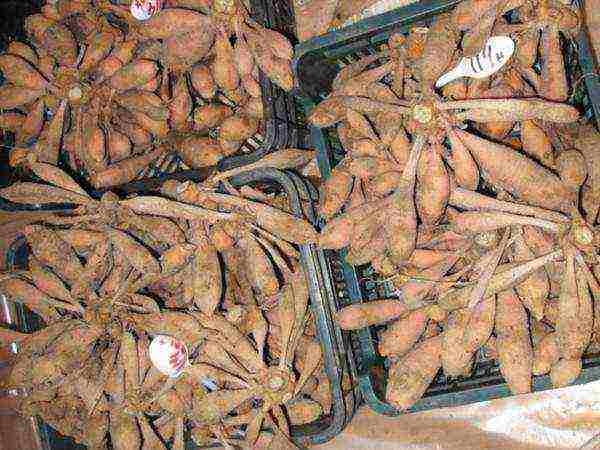 There are several ways to store tubers in winter. Each gardener chooses the most convenient for himself. The main thing is to ensure the safety of the planting material.
There are several ways to store tubers in winter. Each gardener chooses the most convenient for himself. The main thing is to ensure the safety of the planting material.
You can also store tubers by treating them with a clay mash. Peeled root tubers are washed under running water, dried in the sun, dipped in a chatterbox and dried again. The resulting "dragees" are sent for storage until spring.
Bush formation
In the case when the reproduction of dahlias took place in tubers, it is recommended to leave the two strongest shoots for each seedling, removing all the rest as early as possible. Cuttings are grown, as a rule, in one stem, sometimes pinching the top above the third internode to give splendor to the bush.
 As a rule, dahlias are grown in 1 or 2, less often 3, stems, so as not to thicken the bush too much
As a rule, dahlias are grown in 1 or 2, less often 3, stems, so as not to thicken the bush too much
For large-flowered varieties, a mandatory measure is the regular and complete removal of all stepchildren formed on the stem - lateral shoots in the leaf axils. This is done as early as possible and as close to the stem as possible. If the stepchildren are not removed, especially on the lower part of the stem, then the growth of dahlias slows down, the flowering decreases, and the size of the flowers decreases. In addition, stepchildren close to the ground often break off, and fungal infections can easily occur at the site of the break, which will cause the death of the entire plant.
The removal of stepchildren is carried out regularly, from the moment of planting and until the buds are formed. Lateral shoots are removed to the internode preceding the one where the bud was formed.
Important! Dwarf, pompom, collar and small-flowered types of dahlias do not stepchild.
Quite a few species and varieties of dahlias need to be removed not only stepchildren, but also buds. This is especially true for those plants that are grown for further cutting or participation in exhibitions.
As a rule, on the stems of dahlias, buds are formed in groups of three. The middle bud usually develops faster than the others, but at the same time it has a short peduncle, which is not very convenient for cutting. Therefore, the central bud is removed, after which the remaining two develop faster, have a longer peduncle and are distinguished by lush flowering.
During the flowering period, in order to preserve the decorativeness of the plant, faded inflorescences should be removed daily, which spoil the appearance of the bush.
Formation of undersized bushes
Almost all varieties of dahlias are tall - from 160 cm and above. If you need to get a stunted plant, you need to follow the following algorithm:
- At the end of February, parts of the tubers are planted in nutrient soil and placed in a well-lit place at a temperature not lower than + 15-20 degrees.
- After the emergence of shoots, 1-2 are left, the most powerful. The rest can be used as cuttings.
- Above the fourth pair of leaves at the bush, pinch the top.
- As a result, two stems develop from one, each of which is pinched again after the second pair of leaves.
With such a pinching system, the bush does not grow more than 1 meter in height. The grazing of such dahlias is carried out according to the general scheme.
Reproduction and preparation of tubers for planting
Dahlias are propagated by seeds, cuttings or parts of tubers. Since it is quite simple to grow dahlias from tubers, while obtaining 3-5 new ones from one tuber, this method is the most common. Root tubers dug up in autumn in early April begin to prepare for planting. To do this, they are kept for 10 minutes in a solution of potassium permanganate and left in a warm, well-lit room for about a week.
As soon as sprouts 7-9 mm long appear on the tubers, you can start dividing. One medium tuber can usually be divided into 3-5 parts. It is important to ensure that at least 2 kidneys remain on each division. A sharp knife is used for dividing, acting very carefully so as not to damage the root collar.
Recommendation: if dry or rotten parts are found during the division, they are removed, and the cut site is treated with crushed coal or foundation.
The prepared parts of the tubers are planted for germination in boxes with a mixture of sawdust, peat, river sand and humus. They sit in these boxes until the onset of stable heat without recurrent frosts, when they are transplanted into open ground.
Propagation by cuttings
It is recommended every two years to replace old tubers with new ones obtained from sprouted cuttings. Cutting dahlias allows you to update the planting material, preserving the varietal characteristics of the mother plant.
For renewal, the healthiest and most appropriate tuber is selected, planted in nutrient soil at a third of its height. After a while, sprouts begin to appear. When they reach a height of 2 cm, they are cut off and put to rooting.
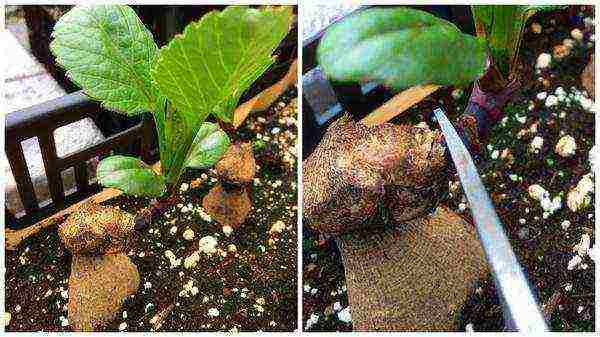 After the sprouts appear, watering is reduced, and the temperature is lowered to + 15-17 degrees so that the cuttings do not stretch
After the sprouts appear, watering is reduced, and the temperature is lowered to + 15-17 degrees so that the cuttings do not stretch
You can root cuttings in water or in a substrate. To accelerate root formation, it is recommended to treat them with stimulants. Cover pots or containers with cuttings with plastic wrap and place in a warm, bright place.
Important! The mother tuber will release new shoots after a while. In total, up to 30 cuttings can be removed from it.
Seed propagation
Typically, seed dahlias are grown as an annual crop. They can be planted in seedlings or sown directly into open ground.
To obtain seedlings, seeds are sown in early April in loose soil, the containers are covered with foil or glass. Seedlings appear already on the 4th-7th day. Two weeks after the emergence of seedlings, they are dived into separate pots. In open ground, matured and pre-hardened seedlings are planted after the end of night frosts, keeping a distance of 20-25 cm between the plants.
When sowing in the ground, the seedlings will need to be thinned out in order to provide the plants with room for growth. Dahlias are sown in May, after the threat of night frosts has passed. Crops will bloom only towards the end of August.
The brightest representatives of annuals are pompon dahlias, varieties "Gelleri", "Sylvia", "Merry Guys"; they are grown from seeds using the same technology.
Despite the fact that dahlias require quite a lot of attention and participation from the gardener, their bright and lush bloom will adorn any flower bed. With some effort, you can admire the luxurious inflorescences until the first frost.
Moscow, Russia, on the site since 11.01.2017
Content:
- Choosing a site for dahlias
- Dahlia fertilizer
- Planting dahlias outdoors and caring for plants
- Dahlia bush formation
Choosing a site for dahlias
The choice of a place for dahlias depends on the purpose of their planting. One approach is needed to choosing a place for setting up a dahlia in a large park and a completely different one - for planting dahlias in a flower farm for reproduction and subsequent sale of root tubers.
We will consider the choice of a place for planting dahlias in order to obtain the greatest decorative effect on the backyards of flower lovers.
Dahlia, grade "Jive"
Our recommendations relate, first of all, to the central zone of the former USSR, as well as to areas close in climatic conditions to the middle zone (for example, the Middle and Southern Urals, southern regions of Western Siberia, Altai, Khabarovsk (southern part) and Primorsky Krai, Belarus, the Baltic republics, the northwestern part of Ukraine, etc. For the southern regions and territories of Russia, Ukraine, the Transcaucasus and especially the Central Asian republics, it is necessary to make appropriate amendments both in terms of planting and harvesting times, and in agricultural technology. take into account some of their biological features: a relatively short growing season, a large need for these plants for moisture, which increases greatly with an increase in the ambient temperature, and a great fragility of their herbaceous stems, which require a garter to stakes (or other supports).
It is necessary to choose a site for planting dahlias in such a way as to provide the most suitable microclimate for them. For plants to grow quickly, it is necessary to warm the soil and planted plants well in order to make the most of the relatively short growing season. Therefore, the site for planting dahlias should be protected from the wind, and above all from the prevailing winds in the area and especially "harmful" for dahlias. In the middle zone and in the eastern regions of the former USSR, such winds are, first of all, the northern, northwestern and northeastern, and for the southern and southeastern regions of the country - the northeastern, eastern and southeastern (i.e. . dry winds). Strong northerly, north-westerly or northeasterly winds, especially at relatively low temperatures (+1 - -4 °), often lead to freezing of plants, especially those freshly planted in the ground from greenhouses and greenhouses and did not have time to get hardened. In the southern and southeastern regions, strong winds carrying dry and heated air dry out plants and soil and can lead to drying (burning) of young leaves and the upper part of dahlia stems.
Dahlia, variety "Osaka"
The site for planting dahlias must be protected from all sides or from the direction of the prevailing winds by trees, buildings, fences, protective belts or fruit trees. If possible, it should be flat or have a southern or southeastern slope (for the southern and southeastern regions, on the contrary, the northern and northwestern slopes less warmed by the sun are preferable). Areas in depressions, in valleys and hollows, where cold air accumulates and late frosts are frequent, are undesirable.
Dahlias planted in large parks among groups of trees and shrubs, as well as along buildings and fences and among fruit trees in the garden, if they are illuminated by the sun at least half the day, grow beautifully and look very decorative.At the same time, planting dahlias near (in the zone of action of the root system) and under the canopy of large trees is unacceptable, since in this case dahlias bloom poorly and do not form viable root tubers. On the site intended for planting dahlias, there should not be a high standing of groundwater (groundwater should not rise above 60-70 cm from the soil surface). With a higher standing of groundwater, a ridges, flower beds or ridges with dahlias must be raised by deepening paths, furrows and the neighboring area. In other cases, it is impractical to make ridges, flower beds or ridges towering above the surrounding area.
In the southern regions with an arid climate, in-depth dahlia planting sites are often arranged, which are surrounded by earthen rollers on all sides so that it is possible to fill the site with water from a ditch, a water pipe or a well at night.
Dahlia, grade "Natal"
The soil on the site intended for planting dahlias must be structural, moisture-absorbing and at the same time permeable. A large part of the failures encountered in growing dahlias are the result of poor soil preparation.
The structure of the soil is improved by adding organic matter to it. Such additives can be manure (fresh or rotted), humus (leaf or manure), composts of various contents, peat, sod land, straw cutting and other organic materials that are easily decomposed in the soil. To increase the permeability of heavy, floating clay soils, sand (especially coarse-grained), gravel, peat, peat and coal ash and even fine (pre-sieved and washed) coal slag can be added, as well as other neutral materials that improve water permeability.
It is recommended to add peat, clay, vermiculite and other moisture-consuming materials to deep sandy soils, which, even with frequent and intensified watering, do not retain moisture in the upper layers of the soil. In passing, it should be noted that the presence of gravel and small pebbles in the soil usually does not interfere with the normal development of dahlias.
Dahlia, variety "Prince Valiant"
If the soil on which the dahlias are to be planted is not structural and sufficient amounts of organic substances that improve the structure are not available at this time, temporarily local improvement of the structure in the pits is carried out.
Usually, gardeners and amateur flower growers face difficulties in preparing the soil for planting dahlias when developing newly allocated plots in collective gardens. Such plots are allotted, as a rule, on field, meadow or forest lands. In such areas, most often the arable layer is thin, or the land is virgin soil (or fallow) with a thin layer of humus and podzolic or clayey subsoil at a depth of 10-15 cm. Such soils very often have strong or very strong acidity (pH 5-4 ). Dahlias, although they put up with excess and lack of acidity in the soil, grow and bloom best of all on slightly acidic and neutral soils. The development of dahlias and strongly alkaline soil inhibits the development. The most correct thing for novice florists is to analyze the soil for acidity. At a pH of 4-5, it is necessary to add slaked lime in an amount of 30 to 100 kg per 100 m2 of area. Soils are highly alkaline with a pH above 8.5 and require acidification. It is best to add peat for this purpose.
For forest and meadow podzolic soils, good results are obtained when a leaf is introduced into the soil during autumn digging and lime - during spring digging. It should be noted right away that the simultaneous introduction of fresh manure or an unripe leaf and lime is undesirable, since freshly slaked lime retards the activity of soil bacteria and prevents the rapid decomposition of manure or leaf. The plot intended for planting dahlias is plowed or dug up deeply in the fall (30-35 cm).In the spring, 2-3 weeks before the dahlia planting date, the plot is plowed or dug up again with careful loosening and harrowing.
Dahlia, grade "Fabel"
The need for dahlias in organic and mineral fertilizers largely depends on the soil on which they are supposed to be planted. To determine the dahlia's need for mineral fertilizers, it is necessary to carry out a chemical analysis of the soil at least once every two to three years. Soil analysis is carried out in soil-agrotechnical laboratories at regional agricultural departments or branches of the Society for the Conservation of Nature, as well as in state and collective farms where there are agricultural laboratories. According to the analysis, the soil demand on the site for mineral and organic fertilizers for the coming years is determined. Soils that have received organic fertilizers rich in humus for many years in a row need these fertilizers to a lesser extent than soils that have recently been developed, which have not previously received organic fertilizers.
For dahlias, fertilizers are applied in three main ways:
- when plowing (digging) a site
- when planting plants in holes
- root and foliar dressing.
Dahlia, grade "Karen"
Fertilizers can affect plants in different ways: effective, ineffective, and even harmful. It all depends on the lack or excess of one or another substance in the soil (as determined by chemical analysis), its acidity, the presence or introduction of necessary trace elements in the soil, the development of beneficial soil bacteria and the timing of fertilization. During autumn plowing (digging), first of all, organic, especially insufficiently decomposed, fertilizers are introduced, for example, manure, peat faeces, various composts; during spring plowing - wood ash, peat (matured), superphosphate. Sometimes, especially when there is a lack of organic fertilizers, a flower mixture or other fertilizer mixtures are applied. Manure and composts are applied in an amount of about 3 to 6 kg per 1 m2, peat faeces and poultry droppings - from 1 to 2 kg. Fertilizing the soil with ammonium and other nitrates, carbamide (synthetic urea), potassium salt, potassium chloride and similar easily soluble chemicals during digging (plowing) is impractical, since they are easily washed out of the arable layer and are not used by dahlias. However, potassium is recommended in clay soils.
In the event that the soil prepared for planting a dahlia is fertile enough, it is advisable to apply fertilizer not to the entire area, but only to the pits during planting. The most suitable fertilizer for this purpose is manure or leaf humus and compost mixed with wood ash or stove soot. Add 3-4 tablespoons of ash to a bucket of humus or compost, mix well and pour about 1/4 of a bucket of mixture into each hole, mix it with soil and plant dahlias. Some breeders put fresh horse manure in the holes when planting a dahlia as fertilizer. This is done as follows: in a previously dug area in places designated for planting, stakes are installed, a 40X40X40 cm hole is dug at each stake, 1/3 of a bucket of horse manure is placed on the bottom of the hole, sprinkled with earth and compacted well with a foot. On top of this land, light humus is poured (from leaf and dung humus with the addition of up to 20 g of superphosphate and a tablespoon of ash to each hole). Mix this mixture well, make a 15 cm deep hole in it and fill it with water. When the water in the hole is completely absorbed, pre-grown dahlias are planted.
Dahlia, variety "Kennemerland"
The timing of planting dahlias in open ground depends on the climatic conditions of the area. In the middle lane, dahlias are planted in open ground after June 1-10 with grown plants.Dahlias can be planted earlier, as soon as the soil warms up enough, from about May 15-20, unforgiven divided tubers with pronounced eyes. After two weeks, shoots appear from the ground. It is necessary to monitor the air temperature and cover the plants if there is a threat of frost.
Some growers, in order to get early flowering of dahlias, plant grown dahlias in the ground ahead of schedule. In this case, prepare shelters from frost
Planting of plants (both cuttings and those grown from divided tubers) is carried out in pre-prepared areas with spaced stakes and holes dug around them. The approximate distance between plants is set at half the height of an adult plant (from 60 to 100 cm in a row), the distance between rows is at least 100 cm. Stakes should be strong, 160-180 cm high. Coniferous stakes are more durable. For their long-term preservation, it is necessary to soak the lower part of the stakes with special compounds, for example, 7% iron sulfate, and paint the stakes themselves with green paint. More durable and comfortable metal stakes. To do this, use old unusable pipes or pieces of reinforcing steel with a diameter of 12-20 mm. The stakes are driven to a depth of 40 cm. After that, a plant is planted closer to the stake (with water in the hole) so that the tuber neck is 4-5 cm below ground level.
Dahlia, grade "Mary Eveline"
Cuttings and hybrid seedlings are usually planted deeper, up to 8-10 cm. Cutting plants are best planted with two plants under each stake. In this case, it is imperative to take into account the growth of plants. When planting dahlias on beds in two or three rows, they try to select plants according to their growth. In the first row, low ones are planted, in the second - of medium height, in the third - tall and very tall varieties, while the shape, color and size of dahlia inflorescences are also taken into account.
It is recommended to plant plants in cloudy weather or in the evening. Cutting plants or plants grown from divided tubers are spilled heavily with water before planting, and then carefully, trying not to damage the plants and not break up the clod, with a lump of earth, are planted in a prepared hole. Around the planted plants, ring-shaped holes are made or the holes are left incompletely filled to ensure the convenience of watering. In the future, when processing the soil, the hole is gradually leveled, and furrows are made for irrigation. The planted plants are immediately tied to stakes (depending on the height of the plant in 2-3 places or more). As the plants grow, the garter is continued. Immediately upon planting, a label is attached to the top of the stake with the name (or number) of the plant.
Dahlia, cultivar "Sieckemanns Feuerball"
In the following days after planting, it is necessary to water the plants regularly and abundantly. The frequency of watering is regulated depending on the temperature and humidity. In dry and hot weather, watering in the first week after planting is carried out daily, later less often, but in such a way that the soil under the dahlias always remains moist. Lack of moisture, especially in dry hot weather, leads to slower growth, lignification of the stem, deterioration of flowering and loss of decorativeness of dahlias, which usually recovers slowly only with the onset of cooler and rainy weather.
The land under the dahlias must be maintained at all times in a loose state, free of weeds. Usually, loosening is done after each watering or top dressing (liquid or dry). After the formation of buds and the closure of the green mass of plants, loosening stops. It is recommended to mulch the soil with humus or peat after the cessation of loosening. Mulching protects the soil surface from crusting, retards the development of weeds, and allows you to reduce the number of watering.
In early September, before the onset of autumn frosts, it is recommended to check the presence of labels and the correctness of the name of the dahlia varieties, to enter a brief description of the variety in the journal (if not done earlier). With the onset of cold weather, you need to spud the dahlias. With a deep planting, hilling can be omitted. Hilling protects dahlias from the first autumn frosts. The hilling height should be 15-20 centimeters.
Dahlia, grade "Karma Amanda"
In dahlias grown from a tuber, it is recommended to leave no more than two shoots, the strongest, all the rest are removed as early as possible. In cuttings plants, as a rule, one stem is left, but sometimes, to give splendor to the bush, pinch the top of the plant above the third node, while the plant develops into two stems.
In large-flowered varieties of dahlias, to increase the size of the inflorescences, all lateral shoots that appear from the axils of the leaves are removed - the so-called stepchildren. If you leave all the stepchildren developing on the stem, especially in its lower part, then flowering slows down and decreases, the size of the inflorescences decreases. Therefore, they should be removed at the very beginning of appearance and as close to the stem as possible. In addition, the lower shoots often break off from the main stem, which increases the possibility of spores of parasitic fungi entering the affected areas, and this can lead to the death of the entire terrestrial part of the plant, especially in wet rainy weather. Dahlias need to be grown regularly, starting from the moment they are planted in open ground and until buds appear in the leaf axils of the main stems. As a rule, all stepsons are removed up to the internode preceding the node with buds.
Dahlia, variety "Seattle"
Pompon, collar, dwarf and all small-flowered varieties of george are not pinned.
In many varieties of dahlias, due to the peculiarity of their budding, it is necessary to remove not only lateral shoots, but also extra buds, especially when dahlias are grown for cutting or for demonstration at exhibitions. Usually, dahlias on a flowering shoot form buds in groups of three, of which the middle bud develops faster, but it often has a shorter peduncle, sometimes not very suitable for cutting. In such cases, the middle bud must be removed, then the lateral buds grow longer peduncles with lush inflorescences. In dahlias of powerful development, regardless of their height, in addition to the stepsons, part of the lower leaves is removed if they cover the root collar. This promotes better ripening of the tubers and prevents a strong thickening of the trunk.
The formation of the bush begins after the appearance of stepsons or pinching the top after the fourth pair of leaves.
To obtain undersized dahlia bushes, the tubers, divided into parts, are planted in pots with nutritious soil at the end of February and placed in a bright place with a temperature of 15-20 °. When shoots appear, the strongest are left (one or two), the rest are broken into cuttings. When the fourth pair of leaves appears, the top is pinched, two stems grow, and above the second pair of leaves on these stems, the top is pinched again, from one or two initial stems, four or eight have already developed. With this formation, the height of the bush usually does not exceed 1 m, although its varietal feature is a height of more than 160 cm. Plants are formed in the same way for exhibitions. Grasshopping is carried out in the usual way, like in other plants.
In the process of flowering dahlias, faded inflorescences that have lost their decorative effect appear on the bush. They spoil the beauty of the bush. Such inflorescences must be removed daily.
Dahlia, variety "Pink Giraffe"
Used materials: Dahlias. Edited by Professor N.A. Basilevskaya. Moscow University Publishing House. 1984 year
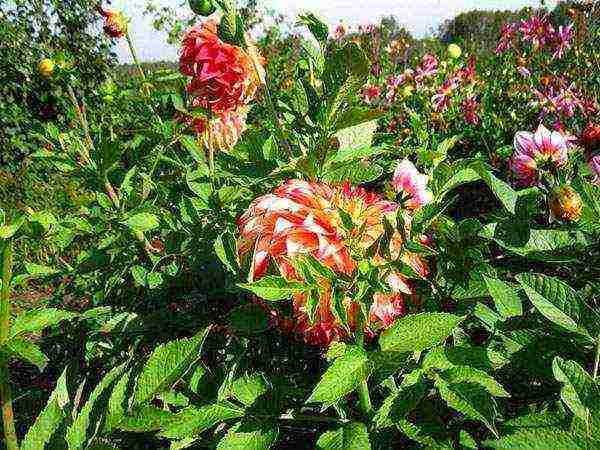 Guatemala and Mexico are considered to be the homeland of these beautiful flowers.Dahlias appeared in the Old World in the 18th century, where they began to successfully plant and care in the open field. The flowers were immediately given two names - dahlia and dahlia. The first name was given to the plant in honor of the famous botanist from Sweden - A. Dahl, and the second - to the scientist from St. Petersburg - I. G. Georgi.
Guatemala and Mexico are considered to be the homeland of these beautiful flowers.Dahlias appeared in the Old World in the 18th century, where they began to successfully plant and care in the open field. The flowers were immediately given two names - dahlia and dahlia. The first name was given to the plant in honor of the famous botanist from Sweden - A. Dahl, and the second - to the scientist from St. Petersburg - I. G. Georgi.
Flower varieties
 Dahlia is a gorgeous flower. In addition to the variety of shapes, it is distinguished by a variety of colors. Today, scientists have about 30 species and about 15,000 varieties of dahlia.
Dahlia is a gorgeous flower. In addition to the variety of shapes, it is distinguished by a variety of colors. Today, scientists have about 30 species and about 15,000 varieties of dahlia.
Botanists divide the flower into the following groups:
- Simple.
- Anemonic.
- Collar.
- Peony.
- Decorative.
- Spherical.
- Pompom.
- Cactus (needle-like).
- Semi-cactus.
- Nymphaeic.
- Mixed - other varieties that are not included in the previous groups.
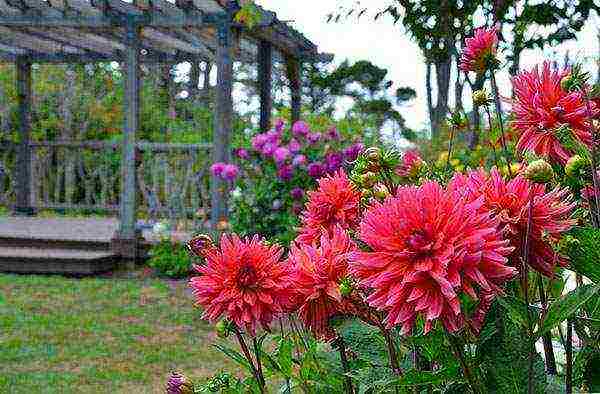 Colorful, gorgeous dahlias of different colors (white, burgundy, scarlet, pink, cream and many others) are the decoration of our summer gardens.
Colorful, gorgeous dahlias of different colors (white, burgundy, scarlet, pink, cream and many others) are the decoration of our summer gardens.
The dream of breeders is the blue dahlia. However, the efforts of botanists have so far not been crowned with success.
However, these delicate flowers cannot stand the harsh Russian winters, so those who want to enjoy the beauty of their bright buds all summer long should plant the tubers annually. So, in the Moscow region, dahlias can be planted in open ground in mid-May. But in its homeland - in Latin America - this amazingly beautiful flower is a perennial.
Planting dahlias in open ground
The most convenient and effective method of growing dahlias is planting and care in the open field.
Land preparation
The soil for flowers is harvested in advance. Prepare the soil for planting dahlia before the onset of winter frosts. In the fall, the earth is dug up and fertilizer is introduced into it - either compost or humus, which are added to the soil at the rate of 4 kg per 1 m2.
In the spring, the soil is again enriched with a mixture of compost and ash, which are scattered over the entire area of the flower bed. Then the earth must be loosened with a rake. Fertilizer can also be added to prepared planting holes.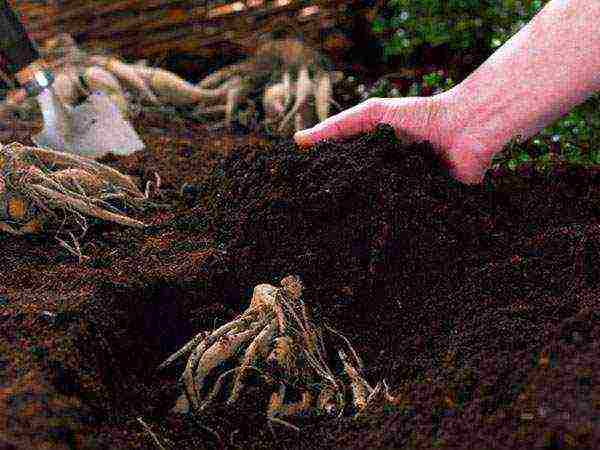
Dahlias are planted in the spring in the soil with a loose structure. Gravel, river sand, crushed coal slag will help to increase its permeability and fertility. This drainage will keep the crop free from excess moisture that can cause harmful mold and rot.
Dahlia quickly deplete the soil, so they should not be planted in one place for two years in a row.
It is desirable that the reaction of the soil is slightly acidic or neutral. Slaked lime is added to the peroxidized soil, and a little peat is added to the alkaline one.
Tuber preparation
Dahlia tubers intended for planting in the open field need special care. With the onset of April - move the root tubers from the cellar to the greenhouse, remove the rotten areas. Put in boxes, cover half with fresh turf soil, peat, sand, sawdust. The root collar is left open. Water the substrate periodically. Eyes will appear in about ten days. Remove root tubers from the soil, shake off, put on a hard surface.
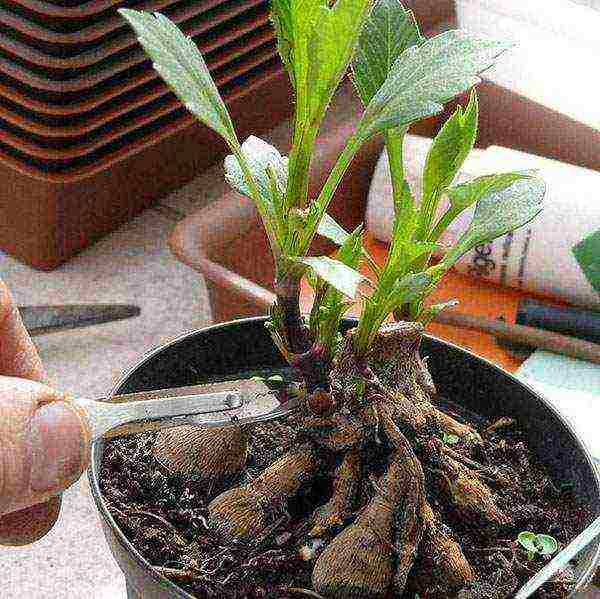 A thin knife blade must be sterilized with a manganese solution or ignited in a fire. Divide the stem into four parts (quarters) with a vertical cut. Each division must have several root tubers and at least one regeneration bud, otherwise it will not be able to germinate. The cut is sprinkled with crushed activated carbon. Keep tubers in the greenhouse until they take root.
A thin knife blade must be sterilized with a manganese solution or ignited in a fire. Divide the stem into four parts (quarters) with a vertical cut. Each division must have several root tubers and at least one regeneration bud, otherwise it will not be able to germinate. The cut is sprinkled with crushed activated carbon. Keep tubers in the greenhouse until they take root.
Approximately 30 days before disembarkation, the planting material is taken out of storage. The tubers are cleaned of damaged tissue by sprinkling the cut site with activated carbon. You can treat the culture with foundation, or hold it for 17 - 18 minutes in a weak solution of manganese. Next, the processed tubers are placed in low containers with a mixture of earth and river sand.
Initially, the containers are kept in a warm, shaded area with moderate watering.When the sprouts reach a height of more than 2 cm, they are transferred to a lighted place. It is rarely necessary to water the sprouts, it is advisable only to moisten the ground. They are planted in the first decade of May. No need to cover.
When is it better to plant dahlias outdoors in spring? The planting time is related to the climate of the region. For central Russia, this is the third decade of May. For the southern regions - April. For the northern ones, it is the beginning of summer.
Planting dahlias in open ground in Siberia and caring for them should be carried out in the second decade of June.
Site preparation
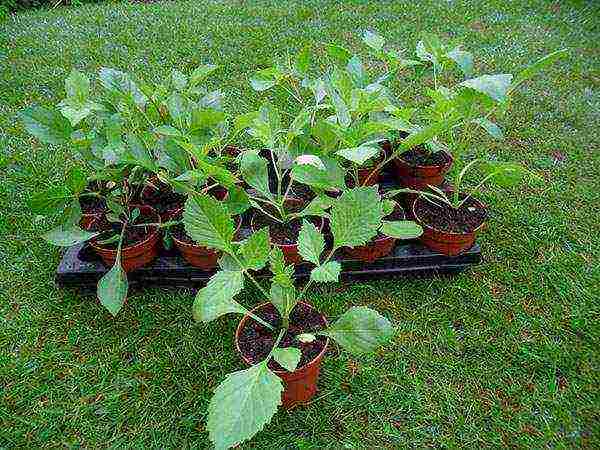 This culture loves warmth, so it is important to choose the right place. A flower bed should be located in a sunny area that is not blown through by drafts.
This culture loves warmth, so it is important to choose the right place. A flower bed should be located in a sunny area that is not blown through by drafts.
Some varieties have a fairly tall stem that breaks off easily from a strong gust of wind. Such varieties need support - stakes made of wood, 1.5–2 meters high. It is advisable to install them in advance.
Ideal location: near the wall, on the south side of the building. It is recommended to plant flowers next to a group of shrubs and trees, in a sufficiently lighted area. However, trees near flowers should not give a thick shade, as dahlias are very fond of light. Closeness and impassable thickets are not suitable for these freedom-loving flowers.
First, the site is leveled, after which the holes are prepared. The tubers are planted in open ground, then they are covered with a layer of earth a few centimeters. Provide enough sun and light watering for the tubers.
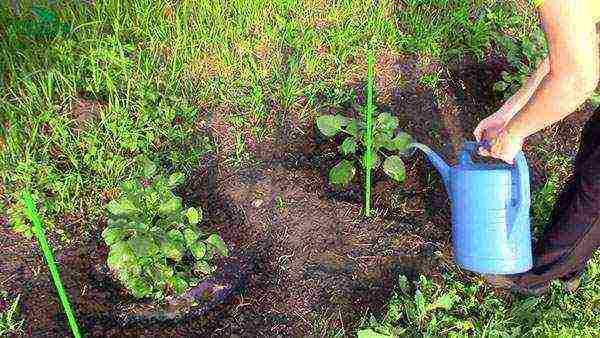 There is another method of propagation of this culture - cuttings. But this is a very laborious and responsible occupation. And if you are worried about these troubles, then you can grow an annual plant from seeds, these are:
There is another method of propagation of this culture - cuttings. But this is a very laborious and responsible occupation. And if you are worried about these troubles, then you can grow an annual plant from seeds, these are:
- ColtnessHybrids;
- Redskin;
- Rigoletto;
- Figaro.
Seeds are sown in open ground in mid-May and bloom by mid-August. To get early flowering, the seeds will have to germinate.
Collection and storage of root tubers
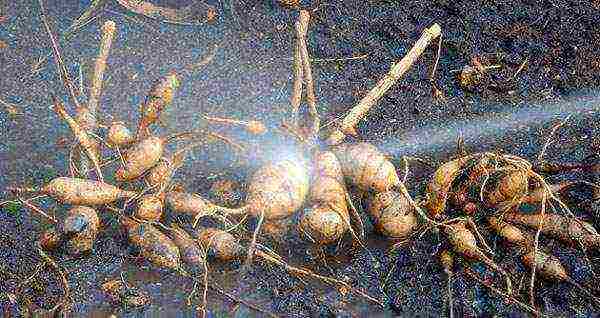 Dahlias planted in open ground in the fall also need care. Before frost, the bush should be spud and the leaves on the bottom of the stem should be removed. It is recommended not to rush to dig up the tubers! When the ground part dies, it is cut off, and the tubers are left in the ground. Within two weeks, their rind will harden and starch will form. And only after the first frost (before the onset of large frosts) the root tubers should be dug up and washed. This is done in the morning so that they air dry during the day.
Dahlias planted in open ground in the fall also need care. Before frost, the bush should be spud and the leaves on the bottom of the stem should be removed. It is recommended not to rush to dig up the tubers! When the ground part dies, it is cut off, and the tubers are left in the ground. Within two weeks, their rind will harden and starch will form. And only after the first frost (before the onset of large frosts) the root tubers should be dug up and washed. This is done in the morning so that they air dry during the day.
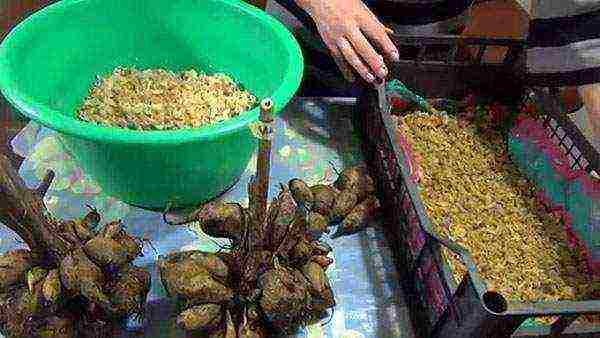 Planting material is stored in a cellar, in a box with a mixture that includes earth, vermiculite, sand, sawdust, peat. The optimum room humidity is 60–70%.
Planting material is stored in a cellar, in a box with a mixture that includes earth, vermiculite, sand, sawdust, peat. The optimum room humidity is 60–70%.
Ventilate the storage periodically.
In January, it is necessary to re-examine the tubers in order to divide large ones. If affected areas are found, it is necessary to remove them, and treat the cut sites with brilliant green solution (you can lubricate with crushed activated carbon).
Dangerous pests
The most important enemies of the plant are:
- aphid;
- slug;
- color beetle;
- Caterpillar;
- earwig;
- etc.
To fight slugs, the earth is sprinkled with metaldehyde. From aphids - the shoots are dipped in a soapy solution or sprayed with a 0.2% chloroethanol solution. Hot weather favors the development of spider mites, which infect the lower part of the leaves. They turn yellow, dry and die. The diseased culture is irrigated with celtan (0.2%). A decoction of celandine and wormwood is also used against pests.
It is recommended to plant marigolds near dahlias - many pests cannot stand their smell.
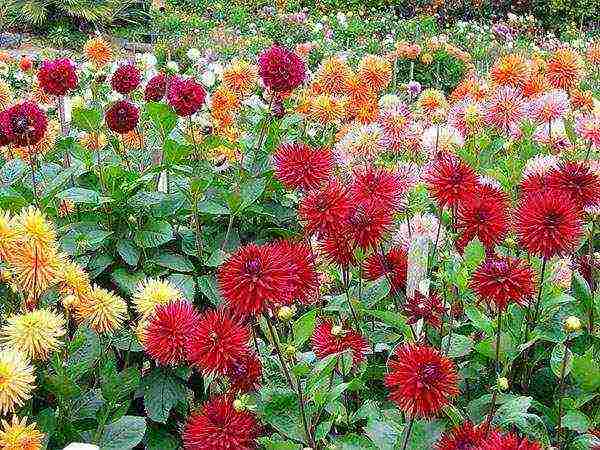 So, magnificent dahlias are distinguished by a variety of shapes and colors, lush long flowering. If you follow the above recommendations, you can easily grow these gorgeous flowers in your backyard.
So, magnificent dahlias are distinguished by a variety of shapes and colors, lush long flowering. If you follow the above recommendations, you can easily grow these gorgeous flowers in your backyard.
All about planting dahlias in open ground - video

